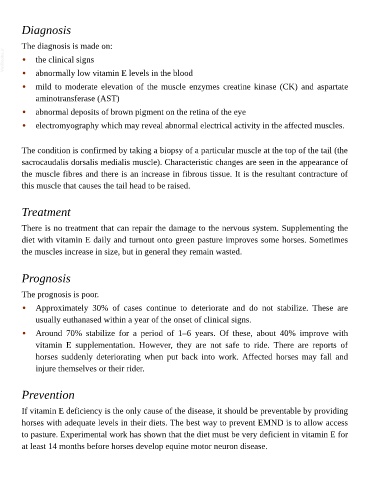Page 495 - The Veterinary Care of the Horse
P. 495
Diagnosis
The diagnosis is made on:
VetBooks.ir • the clinical signs
• abnormally low vitamin E levels in the blood
• mild to moderate elevation of the muscle enzymes creatine kinase (CK) and aspartate
aminotransferase (AST)
• abnormal deposits of brown pigment on the retina of the eye
• electromyography which may reveal abnormal electrical activity in the affected muscles.
The condition is confirmed by taking a biopsy of a particular muscle at the top of the tail (the
sacrocaudalis dorsalis medialis muscle). Characteristic changes are seen in the appearance of
the muscle fibres and there is an increase in fibrous tissue. It is the resultant contracture of
this muscle that causes the tail head to be raised.
Treatment
There is no treatment that can repair the damage to the nervous system. Supplementing the
diet with vitamin E daily and turnout onto green pasture improves some horses. Sometimes
the muscles increase in size, but in general they remain wasted.
Prognosis
The prognosis is poor.
• Approximately 30% of cases continue to deteriorate and do not stabilize. These are
usually euthanased within a year of the onset of clinical signs.
• Around 70% stabilize for a period of 1–6 years. Of these, about 40% improve with
vitamin E supplementation. However, they are not safe to ride. There are reports of
horses suddenly deteriorating when put back into work. Affected horses may fall and
injure themselves or their rider.
Prevention
If vitamin E deficiency is the only cause of the disease, it should be preventable by providing
horses with adequate levels in their diets. The best way to prevent EMND is to allow access
to pasture. Experimental work has shown that the diet must be very deficient in vitamin E for
at least 14 months before horses develop equine motor neuron disease.

